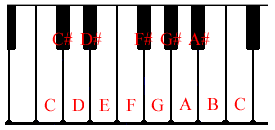
One Octave
This document is in no way complete, nor 100% accurate. It is merely a simple introduction to some basic music terminology so that you can do the lab. Much of the material is has circular references, so you may want to read it a couple of time so that you get the basic idea.

Note: A named pitch. Virtually all music is composed of a collection of notes, and generally does not use frequencies (pitches) that are not notes. Using non-note pitches is often refered to as being "out of tune" or "off key" (although there are other meaning for those phrases also). For example, the A above "middle" C is exactly 440 Hz.
Semitone: The smallest possible step between notes. There is one semitone between each successive note, for example, there is one semitone between C and C#, and there are no notes between C and C#.
Octave and Accidentals : An octave is a range of notes. An octave covers 12 semitones, and contains 13 notes. One octave includes one note of each note name. notes that are seperated by a distance of one octave have the same name. For example, "middle" C and "high" C are both C's, and are one ocatve apart. An ocatve starting on C has the following sequence of notes: C C# D D# E F F# G G# A A# B C. Each octave follow the same sequence. Ocatves may start on any note. The notes {C,D,E,F,G,A,B} correspond to the white keys on keyboard instruments, such as a piano. The other notes, which are followed by a #, are called accidentals, and correspond to the black keys. The note C# is said "C sharp". Note that there is no E# or B#. Another type of accidental is the "flat". While adding a sharp to a note raises it by one semitone (eg. C -> C#), a flat moves a note down a semitone. Thus, C# is the same note (same pitch) as Db (b means flat). So, the octave given above could be written using flats instead of sharps as: C Db D Eb E F Gb G Ab A Bb B C. Again, note that there is no Cb or Fb, since (C and B), and (E and F) are only one semitone apart (so Cb would actually be the same note as B, but musicians would never write that).
Transposition: Transposing means to take a piece of music, and raise (or lower) all the notes by the same number of semitiones. This way, the music is higher or lower in pitch, but the distance between notes stays the same, so that the music still sounds the same. This is useful for a number of reasons. Perhaps there is a song that you wish to sing, but some of the notes are too high (or low). In this case, you could transpose the music down (or up) so that you could sing all the notes. This is often done wherever people sing together, such as churches or campfires. Another use of transposition is for getting all band instruments into the same key. As odd as this sounds, not all instruments play in the same base pitch. What this means is that when, for example, a saxaphone plays a C, this might be a Bb for a piano! So, if the composer of the music that the band is playing has not made all the different parts for the band, someone might have to, say, transpose a trumpet score (music sheet) so that it can be played at the same pitch by a trombone.
MIDI: To find out about MIDI, visit www.midi.com. Here is their description of what is MIDI? For our lab, we are only using the MIDI note numbers, and the MIDI_TONE unit generates the appropriate frequency. So we are using MIDI notes to produce the approproate MIDI tone, but other than that there is nothing to do with MIDI.